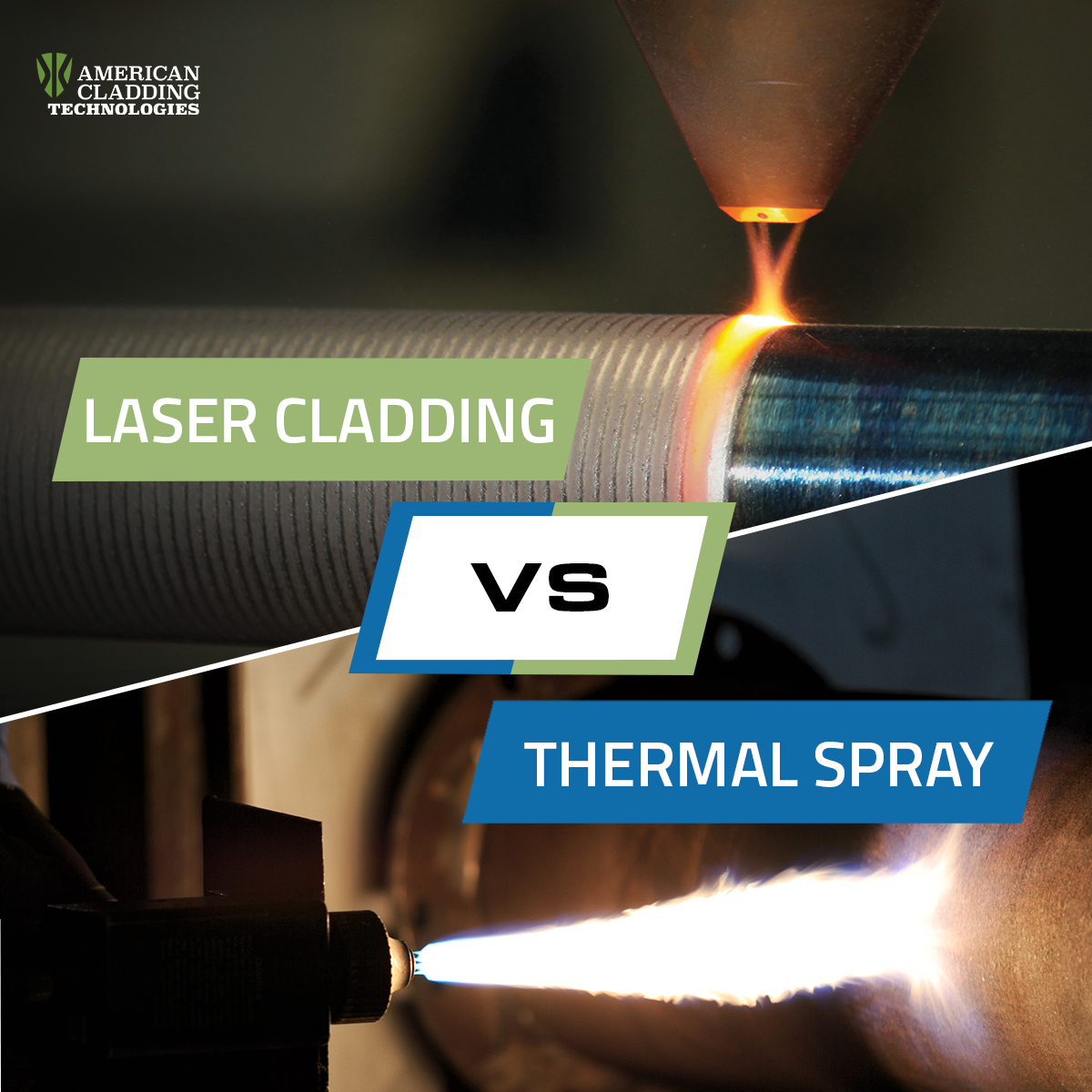
Exploring Laser Cladding as a Thermal Spray Alternative
Whether you’re looking to restore heavy duty industrial components, or extend their lifetime before installation, this guide will help you evaluate laser cladding as a thermal spray alternative.
Laser Cladding & Thermal Spray Defined
Let’s start with a quick review of how each method works.
Laser cladding is an additive process. A laser heats the metal and deposits layer by layer onto a metallic substrate. This process manufactures, strengthens and restores heavy duty industrial components such as pump shafts and turbine blades.
Thermal spray is also used to restore surfaces, although it works a bit differently. One thermal spray process, HVOF (high velocity oxygen fuel coating) mixes fuel and oxygen, which travel into a combustion chamber and ignite. The resulting hot gas flows through a nozzle at extremely high speeds. Powder is added to the mix and is used to coat the workpiece.
Other variations of thermal spray include plasma spray, wire arc spray, flame spray, and high velocity air fuel spray (HVAF).
Both laser cladding and thermal spray restore and enhance hardworking components. Each process applies a coating designed to withstand harsh conditions. Corrosion resistance and wear resistance are two of the top issues mitigated by adding a coating.
The Key Differences Between Laser Cladding and Thermal Spray
There are a few key differences between the two processes:
Laser cladding forms a true metallurgical bond
One form of laser cladding called “Laser Metal Deposition” (LMD), uses inert gas to deposit alloyed metal powder into a laser beam creating a weld pool onto the substrate. The weld interface between the substrate and the filler material is classified as a metallurgical bond, and has a higher bond strength when compared to thermal spray applications. Coatings applied with laser cladding have minimal dilution and the finished product contains little to no porosity.
Thermal spray processes creates a mechanical bond where the coating adheres to the substrate of the component by means of a friction or interlocking bond between the base and additive material. It is not a metallurgical bond. This can result in a porous coating, which is a big reason to use laser cladding as a thermal spray alternative.
Laser cladding can deposit thicker coatings than thermal spray
Laser cladding can produce coatings up to ~3.5 inches (76mm) thick, while thermal spray can go up to 1mm or so (or less) before issues, such as spallation, start occurring. Thickness is also easier to control with laser cladding.
It’s also worth noting that thick coatings aren’t always necessary. Full material properties can be achieved by applying thinner coatings, saving money on powder costs.
Laser cladding can coat internal diameters
Using a laser allows us to coat the internal diameters of tubes, pipes, and cylindrical components using a process called I.D. Cladding. This type of coating is tougher to achieve with thermal spray processes, though not impossible.
Thermal spray is portable
Laser cladding happens in a stationary facility. Thermal spray is portable. This is helpful for applications where field service is preferred, such as machinery used in the construction industry. Let’s take bucket loaders for example. They work hard, digging, scooping and moving sand and other material around all day long. The resulting friction causes the teeth to wear down. It’s quicker and more efficient to service these in the field with a portable thermal spray operation, rather than in a plant. However, for new equipment, OEMs may prefer laser cladding due to the increased durability and longevity it provides.
Application Examples
Boiler tubes
Laser cladding performs extremely well with applications that require a lot of thermal cycling, such as waste to energy boilers. Here, the tubes heat up to 1600/1800°F, then cool, and then heat up again. When the coating expands at a different rate than the tube, the shear force at the bond interface can lead to premature failing or spalling. This can cause pieces to chip or break off. The shear force can be quite severe, causing costly downtime if the superheater tubes aren’t properly treated.
Working steel mill rolls
In steel mills, hot molten metal pours from furnaces onto rollers which shape products ranging from flat sheet metal to I-beams. As you can imagine, these rollers wear out quickly, thanks to the temperature differential. Rollers coated using HVOF are likely to chip and get damaged. These impaired areas allow water to get in, causing the roller to degrade very quickly. With a metallurgical bond, the metal will not chip or flake, and will be more resistant to abrasion.
Should I Use Laser Cladding as a Thermal Spray Alternative?
It depends! Here are a few cases where we recommend laser cladding:
- If your component has high impact requirements.
- You’d like to achieve a strong metallurgical bond created with relatively low heat input.
- You dream of a one-step process with minimal post-processing required.
- If the component can be transported and coated in a facility like ours.
- To enhance the interior diameter of your component.
